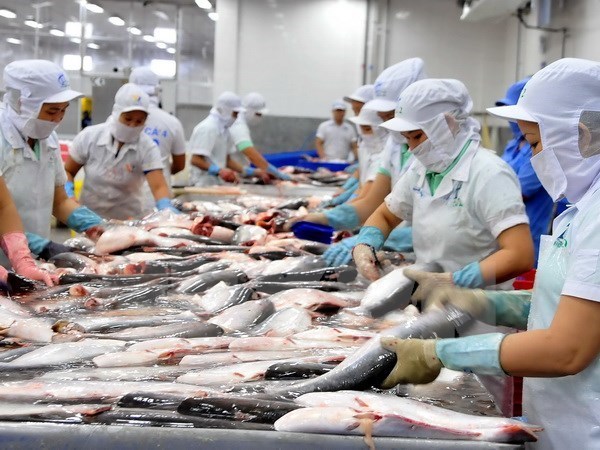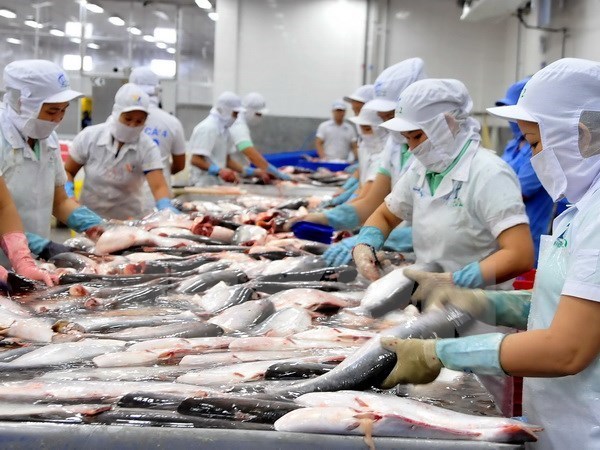
More Vietnamese businesses may soon be allowed to export aquatic products to Russia this year after a Russian working group made a fact-finding tour of some Vietnamese exporters, said Trade Counsellor of Vietnam in Russia Duong Hoang Minh.

A tra fish
processing factory (Photo: VNA)
Minh said Vietnam’s trade office in Russia had earlier held a
working session with local agencies.
The move was made after Vietnam was given a "yellow card” warning by the
European Commission in September 2017 for failing to progress in fighting
illegal fishing, which could lead to a drop in aquatic exports to the EU and
other markets.
The counsellor said exports to Russia have encountered difficulties recently
since this country and the Eurasian Economic Union (EAEU), of which it is a
member, limited aquatic product imports and only allowed 21 Vietnamese
companies to ship products to Russia.
However, there are more than 500 Vietnamese businesses eligible to export to
the EU and other demanding markets at present. Therefore, the trade office of
Vietnam has worked with the Ministry of Agriculture and Rural Development to
persuade Russian agencies to lift barriers to Vietnamese aquatic products.
It also invited relevant agencies of Russia and the EAEU to make fact-finding
tours to Vietnam in an effort to have more companies be allowed ship aquatic
products to these markets, Minh added.
In 2017, Vietnam exported 2.2 billion USD worth of goods to Russia, up 35
percent year on year. Commodities with high export growth included vegetables,
fruits, cashew nuts, textiles-garments, wood products, machinery and spare
parts.
The counsellor said the Vietnamese trade office in Russia will now focus on
helping businesses boost shipments and capitalise on the Vietnam-EAEU Free
Trade Agreement.
It will also continue working to understand regulations and commitments in the
World Trade Organisation and free trade agreements, as well as possible trade
barriers.
Source: VNA
Since the beginning of this year, under the direction of the Department of Agriculture and Environment, the Sub-Department of Agricultural, Forestry, and Fishery Product Quality Management has strengthened the integration of the professional activities to promote and guide the organizations and individuals in the production and trading of agricultural, forestry, and fishery products to comply with the legal regulations regarding the use of chemicals, pesticides and veterinary medicines in crop cultivation, livestock farming and aquaculture. They also provide guidance to processing and manufacturing establishments on keeping the records to trace the product origins and using food additives from the approved list according to the regulations.
Hoa Binh province saw a significant rise in state budget revenue in the first two months of 2025, heard a meeting chaired by Vice Chairman of the provincial People’s Committee Quach Tat Liem.
Ha Thi Ha Chi, a 26-year-old graduate in law, has taken an unconventional path by returning to her hometown in Mai Chau district to establish the Tong Dau Cooperative, creating stable jobs for local women and bringing Thai ethnic brocade weaving to the global market.
As the Lunar New Year 2025 approached, pork prices surged, creating a profitable season for farmers in Tan Vinh commune, Luong Son district. Taking advantage of the rising demand, Can Minh Son, a farmer from Coi hamlet, sold over 30 pigs at 69,000 VND/kg, each weighing more than 100 kg. After deducting expenses, his family earned a profit of over 50 million VND.
alternate member of the Central Party Committee, Secretary of the Hoa Binh provincial Party Committee Nguyen Phi Long on March 5 had a working session with Yan Jiehe, Founder and Chairman of the China Pacific Construction Group, one of China's largest private corporations in the field of transport infrastructure. Deputy Secretary of the provincial Party Committee, Chairman of the provincial People's Committee Bui Duc Hinh and leaders of provincial departments and sectors also attended the working session.
The electronic printed circuit board (PCB) manufacturing and processing plant of Japan’s Meiko Group, located at Da River Left Bank Industrial Park in Hoa Binh city with a total investment of over 200 million USD, is expected to create thousands of jobs and make a significant contribution to the local budget.



